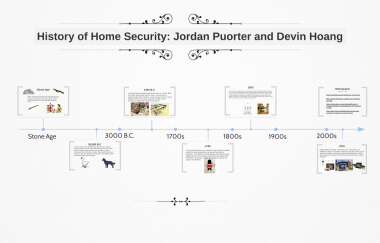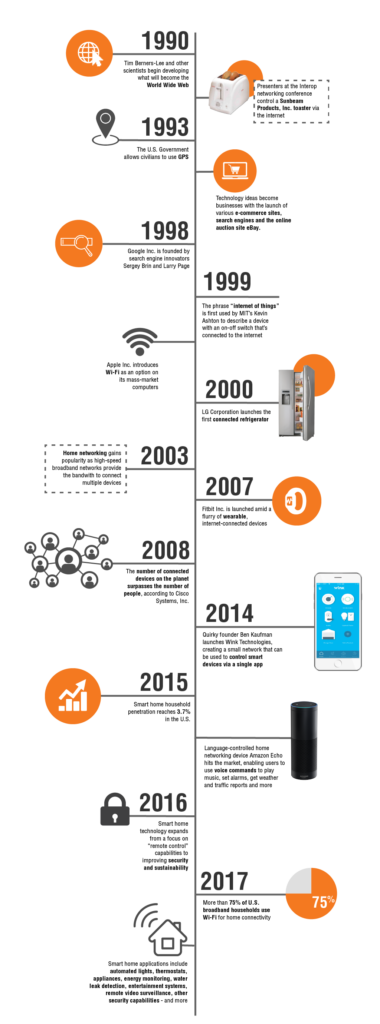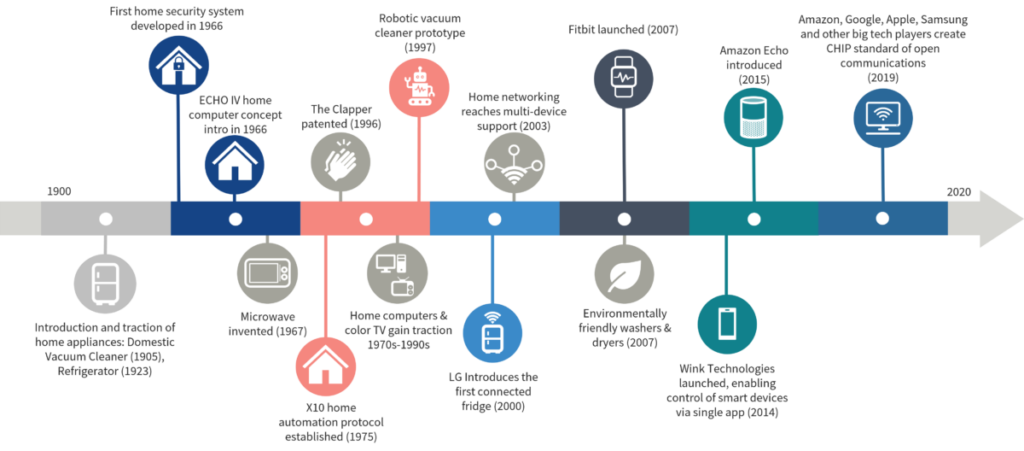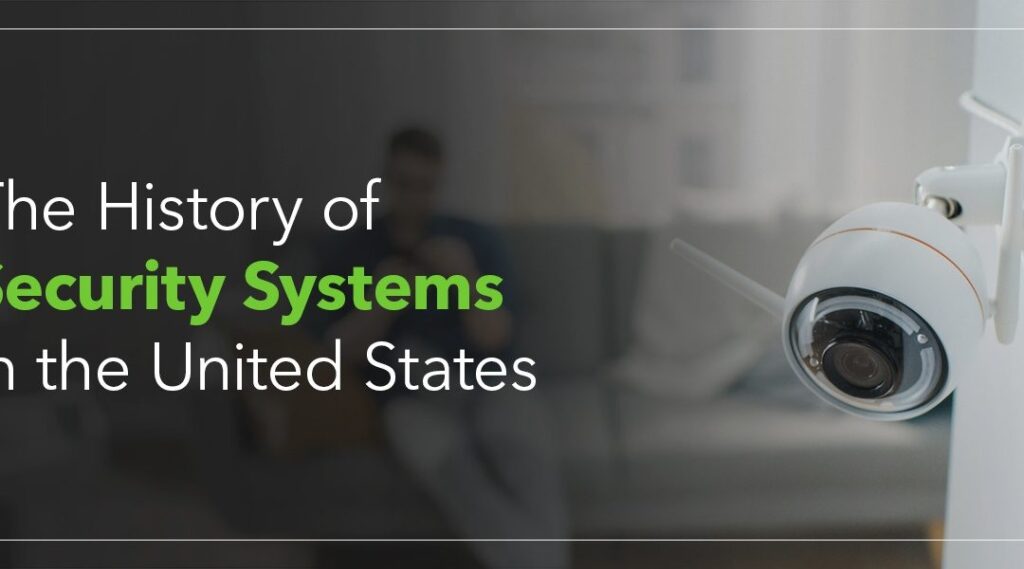Imagine stepping into a time machine, traveling back through the decades, and witnessing the remarkable evolution of home security firsthand. From basic locks and alarms to advanced surveillance systems and smart technology, the landscape of protecting our homes has undergone a staggering transformation. In this article, you’ll embark on a captivating journey through time, exploring the key milestones and innovations that have shaped The Evolution of Home Security: A Timeline. Discover how ancient civilizations used ingenious methods to safeguard their dwellings, witness the emergence of cutting-edge security systems, and catch a glimpse of the future where homes seamlessly integrate state-of-the-art protection. Get ready to be amazed as we unravel the intricacies of the past, present, and future of home security.
Early Forms of Home Security
Fire Alarm Systems
One of the earliest forms of home security was the invention of fire alarm systems. These systems were designed to detect and warn individuals of the presence of fire in their homes. They typically consisted of a series of interconnected smoke detectors that would sound an alarm when smoke was detected. These early fire alarm systems were crucial in alerting homeowners to potential fire hazards and allowing them to take action to mitigate the risk of damage to their homes.
Guard Dogs
Another early form of home security was the use of guard dogs. People have been using dogs as protectors for centuries, and their keen senses and loyalty made them an effective deterrent against intruders. Guard dogs were trained to be protective of their owners and their property, and their presence alone was often enough to discourage potential burglars or intruders. The use of guard dogs as a form of home security continues to this day, although their role has evolved with the advancements in technology.
Locks and Keys
Locks and keys have been used as a means of securing homes for centuries. The invention of the lock and key system allowed homeowners to safely lock their doors, preventing unauthorized access to their properties. Initially, locks were simple mechanical devices that required physical keys to unlock. However, with advancements in technology, modern locks have become more sophisticated, using electronic or digital technology to provide increased security. Despite their simplicity, locks and keys remain a fundamental component of home security systems.
The Emergence of Electronic Security Systems
The Invention of the First Security Alarm System
The invention of the first security alarm system marked a significant milestone in the evolution of home security. The first known security alarm system was developed by a Scottish inventor named Andrew Bell. In 1858, Bell created a system that used electromagnetic contacts to trigger an alarm when a door or window was opened. The system relied on a simple circuit and a bell, which would ring loudly when the circuit was broken. This innovation laid the foundation for more advanced electronic security systems that would emerge in the future.
The Introduction of Closed-Circuit Television (CCTV)
The introduction of closed-circuit television (CCTV) revolutionized the field of home security. In the 1940s, the first CCTV system was developed in Germany for monitoring the launch of V-2 rockets. Soon after, CCTV systems were adopted for commercial and residential use, allowing homeowners to monitor their properties in real-time. CCTV systems typically involve the use of video cameras, which capture footage of the surroundings. This footage is then transmitted to a monitor or recording device for viewing or storage. CCTV systems provide a visual deterrent to potential intruders and serve as a valuable tool for surveillance and identification.
The Shift to Digital Security Systems
With advancements in digital technology, home security systems have evolved from analog to digital systems. Digital security systems offer enhanced capabilities such as high-resolution imaging, remote monitoring, and advanced video analytics. Digital security cameras capture and process images in a digital format, allowing for improved image quality and easier integration with other digital systems. The shift to digital security systems has significantly enhanced home security, providing homeowners with more comprehensive and flexible surveillance options.
Advancements in Alarm Technology
Wireless Alarm Systems
Wireless alarm systems have emerged as a convenient and versatile option for home security. Unlike traditional wired systems, wireless alarm systems do not require extensive installation and wiring throughout the property. Instead, they utilize wireless technology, such as radio frequencies or Wi-Fi, to transmit signals between the various components of the system. Wireless alarm systems offer greater flexibility in terms of placement and scalability, allowing homeowners to easily expand or modify their security systems to meet their specific needs.
Smart Home Security Systems
Smart home security systems have revolutionized the way homeowners protect their properties. These systems integrate various smart devices, such as motion sensors, door/window sensors, security cameras, and smart locks, into a single interconnected network. Smart home security systems can be controlled remotely through mobile applications, providing homeowners with real-time access to their security settings, live feeds from security cameras, and the ability to arm or disarm the system from anywhere. The integration of smart technology into home security systems has enabled seamless automation and enhanced convenience for homeowners.
Integration with Mobile Devices
The integration of home security systems with mobile devices has further enhanced the accessibility and functionality of these systems. Homeowners can now receive notifications and alerts directly on their smartphones or tablets, keeping them informed about any security breaches or events in their homes. Mobile apps also provide the ability to remotely control and monitor security systems, giving homeowners peace of mind and the ability to react to emergencies even when they are away from home. The integration of home security systems with mobile devices has revolutionized the concept of remote home monitoring and control.
Surveillance Evolution
Introduction of Outdoor Surveillance Cameras
The introduction of outdoor surveillance cameras has significantly expanded the scope of home security systems. While early security cameras were primarily used indoors, outdoor surveillance cameras were developed to monitor the exterior of properties as well. These cameras are designed to withstand harsh weather conditions and provide round-the-clock surveillance of the outdoor areas surrounding a home. Outdoor surveillance cameras act as a deterrent, capturing images or footage of suspicious activities, and helping law enforcement identify and apprehend criminals.
Night Vision Technology
Advancements in night vision technology have greatly improved the effectiveness of surveillance systems during low-light or nighttime conditions. Night vision cameras use infrared light to capture images in complete darkness, providing clear visibility in areas where traditional cameras would struggle to capture usable footage. This technology allows homeowners to maintain constant surveillance of their properties, even in the absence of natural or artificial lighting. Night vision technology has bolstered the security capabilities of home surveillance systems, ensuring that no potential threat goes unnoticed.
High-Definition Cameras
The introduction of high-definition (HD) cameras has significantly enhanced the quality and clarity of surveillance footage. HD cameras capture images with superior resolution, allowing for the identification of finer details, such as facial features or license plate numbers. The increased level of detail provided by HD cameras has proven invaluable in investigations and evidence gathering. High-definition cameras have become a standard feature in modern home security systems, providing homeowners with a higher level of visual information and ensuring that potential threats are captured in greater detail.
Home Automation Integration
Integration with Smart Home Platforms
The integration of home security systems with smart home platforms has brought about a new era of convenience and automation. Smart home platforms, such as Amazon Alexa or Google Home, allow homeowners to control and manage various aspects of their homes, including security systems, through voice commands or mobile apps. Integration with smart home platforms enables seamless control and coordination between different smart devices, allowing homeowners to create customized security rules and routines. For example, homeowners can set up a routine that automatically locks doors, turns on lights, and arms the security system when they leave the house.
Voice Recognition Technology
Voice recognition technology has become a prominent feature in modern home security systems. By utilizing voice recognition technology, these systems can identify and authenticate individuals based on their unique voice patterns. This feature adds an additional layer of security by ensuring that only authorized individuals can access or control the security system. Voice recognition technology not only enhances the security of the system but also provides a convenient and hands-free method of controlling the system’s functions.
Remote Access and Control
Remote access and control have become essential features of modern home security systems. The ability to remotely monitor and control security settings and devices provides homeowners with continuous access to their homes, regardless of their physical location. Through mobile apps or web portals, homeowners can view live feeds from security cameras, receive real-time alerts, and remotely arm or disarm the security system. Remote access and control significantly enhance the convenience and flexibility of home security systems, allowing homeowners to respond promptly to any security events or emergencies.
Biometric Security Systems
Fingerprint Recognition
Fingerprint recognition is a biometric security feature that has gained popularity in recent years. Many modern home security systems incorporate fingerprint scanners as a means of identification and access control. By scanning an individual’s fingerprint, the system can quickly and accurately determine their identity and grant or deny access accordingly. Fingerprint recognition provides a high level of security, as fingerprints are unique to each individual and difficult to replicate. This feature ensures that only authorized individuals can gain access to the home or specific areas within it.
Iris Scanners
Iris scanners are another biometric security feature that has found its way into home security systems. Iris recognition technology captures and analyzes the unique patterns and characteristics of an individual’s iris, which are stable and distinct for each person. By scanning the iris, the system can accurately verify the identity of an individual before granting access. Iris scanners provide a high level of security and are difficult to deceive, making them an effective means of protecting homes from unauthorized access.
Facial Recognition
Facial recognition technology has revolutionized biometric security in recent years. Home security systems that incorporate facial recognition technology can analyze and compare the facial features of individuals to determine their identity. This technology allows for quick and accurate identification and provides an additional layer of security. Facial recognition systems can also be programmed to alert homeowners when an unrecognized face is detected, providing an extra level of protection against potential threats. Facial recognition technology has the potential to significantly enhance the security capabilities of home security systems.
Artificial Intelligence and Machine Learning in Home Security
Predictive Analytics
The integration of artificial intelligence (AI) and machine learning algorithms into home security systems has revolutionized the field. These technologies enable security systems to analyze vast amounts of data and identify patterns or anomalies that may indicate potential security threats. Predictive analytics algorithms can learn from past data to anticipate and predict potential security breaches, allowing homeowners to take proactive measures to mitigate risks. AI-powered security systems continuously adapt and improve their performance, ensuring that homeowners always have the most advanced and effective security measures in place.
Behavior Analysis
Behavior analysis is another application of AI and machine learning in home security systems. By analyzing patterns of behavior, these systems can distinguish between normal and abnormal activities, raising alarms when unusual or suspicious behavior is detected. Behavior analysis algorithms can learn to recognize typical patterns and adapt to changes in behavior over time. This technology is particularly useful in identifying unauthorized access attempts, recognizing potential security threats, and preventing breaches before they occur.
Automated Response Systems
The integration of AI and machine learning has also led to the development of automated response systems in home security. These systems can automatically respond to security breaches or emergencies by activating predefined protocols or actions. For example, if an intruder is detected, the system can immediately trigger an alarm, notify the homeowner and relevant authorities, lock doors, activate security cameras, or even initiate emergency calls. Automated response systems ensure that security incidents are handled swiftly and efficiently, minimizing potential damage or loss.
Wireless Connectivity and Cloud Storage
Internet of Things (IoT)
The Internet of Things (IoT) has played a significant role in the evolution of home security systems. IoT refers to the network of interconnected devices that can communicate and exchange data with each other over the internet. In the context of home security, IoT allows various security devices, such as cameras, sensors, or locks, to seamlessly connect and interact with each other. This interconnectedness enables real-time monitoring, remote access, and automation, enhancing the overall effectiveness and convenience of home security systems.
Cloud-based Video Storage
Cloud-based video storage has revolutionized the way surveillance footage is stored and accessed in home security systems. Traditionally, surveillance footage was stored locally on physical storage devices, such as hard drives or network-attached storage (NAS) devices. With cloud-based video storage, footage is securely stored and accessible from anywhere through an internet connection. Cloud storage provides homeowners with the convenience of accessing and reviewing recorded footage remotely, without the need for physical access to the storage devices. It also offers a backup solution in case of damage or theft of local storage devices.
Mobile Alerts and Notifications
Wireless connectivity enables home security systems to send mobile alerts and notifications directly to homeowners’ smartphones or other mobile devices. These alerts and notifications inform homeowners of security breaches, such as unauthorized access attempts, suspicious activities, or triggered alarms. Through mobile apps, homeowners can receive real-time alerts, view live feeds from security cameras, and take immediate action to address any security concerns. Mobile alerts and notifications provide homeowners with peace of mind, knowing that they can be quickly informed of any potential security threats, no matter where they are.
Cybersecurity Challenges and Solutions
Vulnerabilities in Connected Devices
With the increasing interconnectedness of home security systems, there is a corresponding increase in potential vulnerabilities to cyber threats. Connected devices within home security systems, such as cameras, sensors, or smart locks, can be targeted by hackers looking to gain unauthorized access or compromise the system. To mitigate these vulnerabilities, robust cybersecurity measures are essential, including regular software updates, strong encryption protocols, and the use of secure communication channels. Homeowners must also practice good cybersecurity hygiene, such as using strong passwords, enabling multi-factor authentication, and being cautious about granting access or sharing sensitive information.
Security Protocol Encryption
Security protocol encryption is a crucial aspect of protecting home security systems from cyber threats. Encryption involves the process of encoding data in a way that can only be deciphered by authorized parties. By encrypting the communication between devices within a home security system, it becomes much more difficult for attackers to intercept and decipher sensitive information or gain unauthorized access. Strong encryption protocols, such as AES (Advanced Encryption Standard), ensure that data transmitted between devices remains secure and protected from potential threats.
Network Monitoring and Intrusion Detection
To address cybersecurity challenges in home security systems, network monitoring and intrusion detection systems play a vital role. Network monitoring involves actively monitoring network traffic and system logs to identify any suspicious activities or anomalies. Intrusion detection systems utilize intelligent algorithms to analyze network traffic and identify patterns that may indicate a cyber attack or unauthorized access attempt. By implementing robust network monitoring and intrusion detection systems, homeowners can detect and respond to potential cyber threats in a timely manner, minimizing the risk of compromise or data breaches.
The Future of Home Security
Advanced Biometrics
The future of home security is likely to see further advancements in biometric technologies. Biometric systems capable of recognizing a wider range of characteristics, such as gait analysis or heartbeat patterns, may become more prevalent. These advanced biometric systems will provide even greater levels of security, accuracy, and convenience, ensuring that only authorized individuals are granted access to homes.
Robotic Security Systems
Robotic security systems have the potential to transform home security in the future. These systems could incorporate artificial intelligence, machine learning, and autonomous capabilities to patrol homes, detect intruders, and respond to security breaches. Robotic security systems can provide 24/7 surveillance and response, minimizing the need for human intervention and ensuring continuous protection for homeowners.
Virtual Reality Security Simulations
Virtual reality (VR) technology may soon play a significant role in enhancing home security. VR simulations could be used to train homeowners in emergency response procedures and security protocols. By immersing homeowners in realistic virtual scenarios, they can gain practical experience in handling various security situations and improve their ability to respond effectively in real-life emergencies.
The evolution of home security has come a long way, from simple fire alarm systems and locks to the integration of advanced technologies such as AI, biometrics, and cloud storage. The future of home security holds even greater promise, with advancements in biometrics, robotic security systems, and virtual reality simulations. As technology continues to advance, homeowners can expect even higher levels of security, convenience, and peace of mind in protecting their homes and loved ones.






